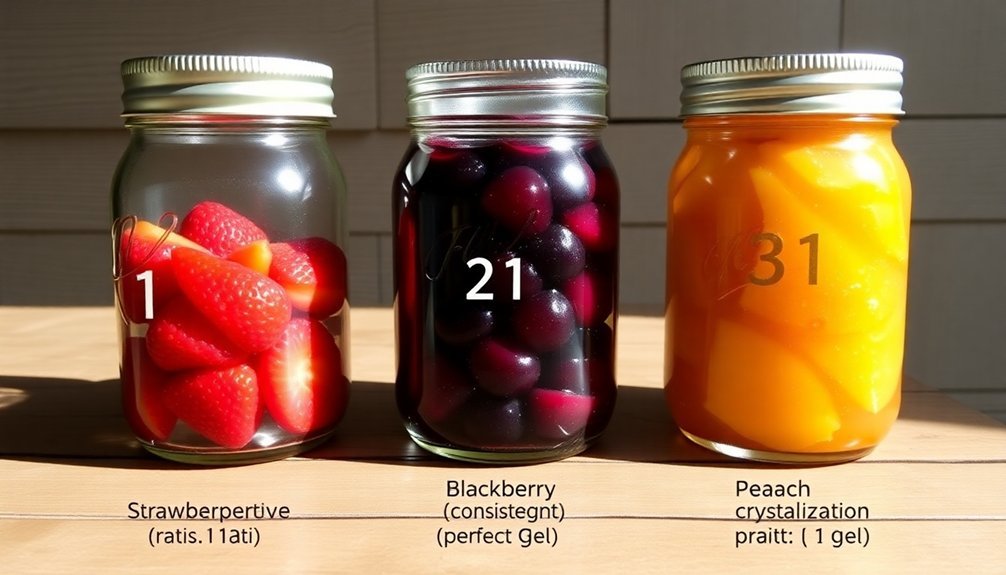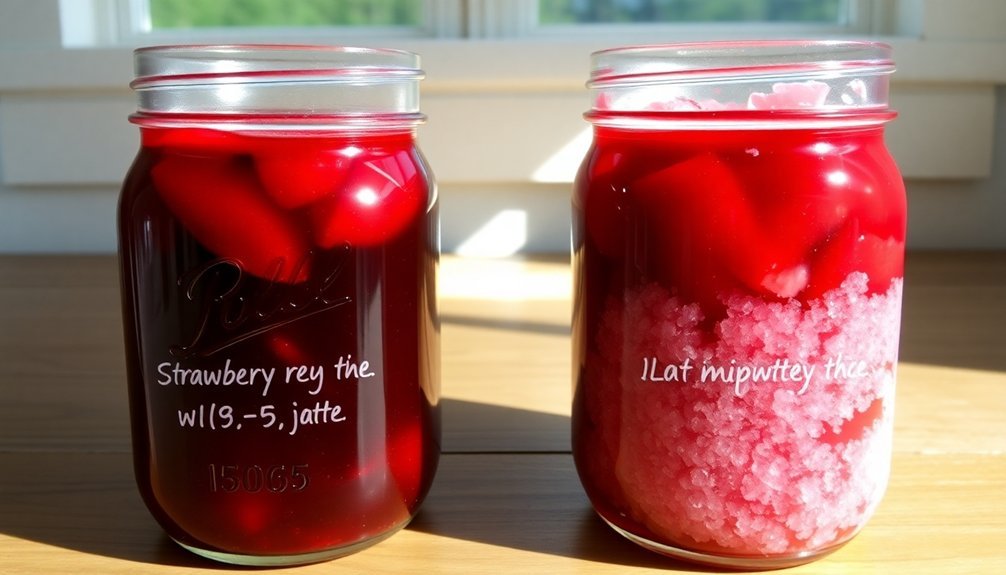For ideal long-term food storage, you'll want to maintain specific sugar ratios across different preservation methods. In fruit preserves, aim for a 60-65% sugar concentration using either a 50:50 or 45:55 fruit-to-sugar ratio. When making honey syrup, stick to either one-to-one or two-to-one honey-to-water proportions. For jam making, use 55 parts sugar to 45-47 parts fruit, depending on the fruit's natural pectin content. With sugar brines, focus on surface coverage while maintaining a 36-40°F temperature. Proper crystallization prevention requires precise measurements and container selection – key details that'll transform your preservation results.
Fruit Preserves Basic Sugar Ratios

When making fruit preserves, you'll need to maintain a sugar concentration of 60-65% in your final product to guarantee proper preservation. This concentration is essential as it reduces water activity and prevents bacterial growth, making your preserves safe for room temperature storage.
You can achieve this preservation standard using several fruit-to-sugar ratios. The most common is a 50:50 split, but you'll also find success with 45:55 or 40:60 ratios depending on your desired consistency. If you're looking for a less sweet option, try using a 1:1/2 ratio (1000g fruit to 500g sugar) or even a 1:1/3 ratio, though this may reduce shelf life. For optimal gel formation, cook your mixture until it reaches 104-105°C (219-221°F).
Always weigh your ingredients rather than measuring by volume for consistent results.
When selecting fruit, combine underripe and overripe pieces in a 1:2 ratio to balance pectin and sugar levels naturally. You'll need to monitor your mixture's Brix values during cooking to confirm you're meeting the minimum 65% soluble solids requirement.
If you're making reduced-sugar preserves, you'll need to add preservatives like sodium benzoate or potassium sorbate to maintain shelf stability.
Honey Syrup Storage Guidelines
For ideal storage of honey syrup, you'll need an airtight, food-grade container and proper storage conditions. Choose glass canning jars or food-grade plastic buckets, but avoid metal containers as honey's acidity can cause rust.
Make sure to label your containers with contents and storage dates for easy identification. High-quality options like Huckle Bee Farms honey produce the best results.
When preparing your honey syrup, use a one-to-one or two-to-one ratio of honey to water, depending on your desired sweetness. Keep water temperature below 110°F to preserve raw honey's natural bacteria.
You can infuse the water with herbs or spices before mixing for additional flavors.
Store your honey syrup in a cool, dark place to maintain its quality. While refrigeration isn't necessary, it's an option – just don't freeze the syrup as this can promote crystallization.
Your properly stored honey syrup can last for several months thanks to honey's natural antibacterial properties.
If your syrup crystallizes, don't worry – gentle heating below 110°F will restore its liquid state.
Check your stored syrup regularly for any changes in color, smell, or flavor. If you notice any signs of spoilage, it's best to discard the syrup and make a fresh batch.
Jam Making Sugar Proportions

Success in jam making depends heavily on achieving the right sugar-to-fruit ratio. You'll need to adjust your sugar proportions based on the type of fruit you're using, with low-pectin fruits like strawberries requiring up to 70% of the fruit's weight in sugar.
For ideal preservation and gel formation, you'll want to reach a final sugar concentration between 60-65%. Adding lemon juice for acidity helps create the optimal environment for pectin bonding and extends shelf life.
When measuring your ingredients, follow these basic guidelines for different fruit types:
- Low-pectin fruits (Group I): Use 55 parts sugar for every 47 parts fruit
- High-pectin fruits (Group II): Use 55 parts sugar for every 45 parts fruit
- For quick calculations, use 45% sugar for fruits like apricots
- Adjust ratios based on the fruit's natural sweetness
You'll know you've reached the right consistency when your mixture hits 221°F, the boiling point for a 65% sucrose solution.
Don't forget to let your fruit-sugar mixture rest for 30 minutes to 24 hours to help draw out natural juices.
If you're using reduced sugar, you may need additional preservatives to guarantee proper shelf life and stability.
Sugar Brine Preservation Measurements
While precise sugar ratios are vital for jam making, sugar brining requires a different approach due to its unique interaction with meat proteins.
You'll need to understand that sugar molecules penetrate meat much more slowly than salt, reaching only a few millimeters deep even after 24 hours of brining.
For effective sugar brining, you'll want to keep your solution temperature between 36-40°F (2-5°C). It's important to cool your brine completely before use and guarantee your meat stays fully submerged, using a weight if necessary.
You'll get better results using liquid sugars like grape juice or honey instead of granulated sugar, as they diffuse more effectively into the meat.
When measuring your sugar brine ratios, remember that the surface effects are more important than deep penetration. You're primarily looking to enhance the Maillard reaction and create complex surface flavors rather than sweetening the entire cut.
After brining, you'll need to rinse and dry your meat to form a pellicle. Don't reuse your brine solution, as this can lead to contamination and compromised food safety.
Crystallization Prevention Sugar Balance

Proper crystallization prevention lies at the heart of successful sugar storage. You'll need to carefully balance your storage conditions and packaging choices to maintain sugar quality over time. Different sugar types require specific handling methods, with pure cane or beet granulated sucrose offering the most stability for long-term storage.
While brown sugars and raw varieties contain natural moisture that shortens their shelf life, commercial filtered honey provides excellent longevity when stored correctly.
- Store your sugars in airtight, moisture-proof containers like glass canning jars or food-grade plastic buckets
- Keep storage temperatures stable and avoid refrigeration, which can introduce unwanted moisture
- Choose opaque containers to protect against light damage and maintain consistent quality
- Avoid metal containers for honey storage unless they're specially lined for food grade use
If you notice crystallization occurring, you can usually reverse it. For granulated sugar that's become lumpy, process it in a food processor to restore its original consistency.
With liquid sugars and honey, place the container in hot water until crystals dissolve. While quality might change slightly after two years, your properly stored sugar will remain safe to use.
Frequently Asked Questions
Can I Substitute Artificial Sweeteners for Sugar in Long-Term Food Preservation?
No, you shouldn't substitute artificial sweeteners for sugar in long-term preservation. They don't provide the same preservative properties, texture, or color retention. Your preserved foods will have shorter shelf life and require refrigeration.
How Do Different Altitudes Affect Sugar Preservation Ratios?
You don't need to adjust sugar preservation ratios at different altitudes. While altitude affects storage conditions like air dryness, it won't change how much sugar you'll need to preserve your food effectively.
Does Adding Pectin Change the Required Sugar Ratios for Storage?
Yes, when you're using pectin, you'll still need the full amount of sugar for proper preservation. While pectin helps with setting, it doesn't reduce your sugar requirements for safe long-term storage of preserved foods.
What's the Minimum Sugar Ratio Needed to Prevent Botulism Growth?
You'll need at least 50% sugar to prevent botulism growth, as this reduces water activity to below 0.92. If you want maximum safety and shelf stability, aim for 67% sugar content.
Can Fermented Foods With Sugar Be Safely Stored Long-Term?
You can safely store fermented foods with sugar long-term if you maintain proper pH levels below 4.6, use airtight containers, and keep them refrigerated. Pasteurized versions can last even longer at room temperature.
In Summary
You've now got the essential sugar ratios needed for successful long-term food preservation. Whether you're making fruit preserves, honey syrup, jams, or sugar brines, you'll want to stick to these tested proportions to prevent spoilage and maintain quality. Don't forget to monitor your stored items for crystallization, and you'll enjoy your preserved foods for months to come. Keep these ratios handy for your next preservation project.





Leave a Reply